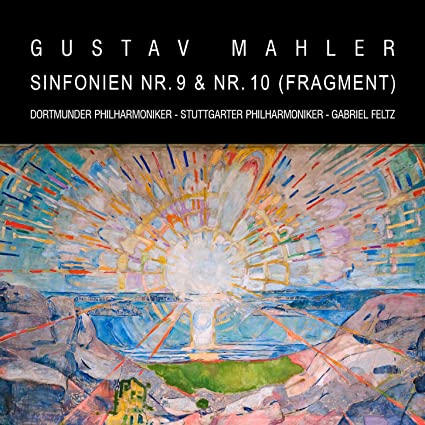

Symphony No. 9 in D Major (Dortmund Philharmonic) Symphony No. 10 in F-Sharp Minor (Stuttgart Philharmonic) Live recordings
I haven't had the opportunity to hear all of the recordings by conductor Gabriel Feltz of the symphonies by Gustav Mahler (1860-1911), but what I've heard I very much enjoyed. You can read here the previous reviews of the Symphony No. 1, Symphony No. 2 and Symphony No. 8. He always captures the essence at the root of each work. The immodest and brazen youthful energy of the First, the theo/philosophical consciousness and uplifting peroration of the Second, and of course the expansive sweep of the Symphony No. 8.
Compared to overly polished, manicured and airbrushed studio recordings, this 'live' take of the Symphony No. 9 in D Major projects a raw, nervous energy throughout its execution which heightens and intensifies the emotional extremes of its peaks and precipices. The tremendous level of pent-up energy released at the end of the Rondo-Burleske movement (audio clip below) is but one example. The generally relaxed tempos applied by Gabriel Feltz make any uptick in momentum really pop. And I haven't witnessed this degree of emotive potency within the final movement since the famous 1982 'live' recording by Herbert von Karajan. And if a profound sense of sorrow doesn't well up in you during the few final pages, primed with such pregnant pauses fraught with anticipation, better check yourself for a pulse.
This 2-Disc set also includes a 'live' performance, this time with the Stuttgart Philharmonic, of the original two-movement fragment of the Symphony No. 10 in F-Sharp Minor, which brings to a close Gabriel Feltz' distinctive complete cycle of the Mahler symphonies. It's obvious here that Gustav Mahler was setting off in new uncharted directions, what with the bold harmonic expansiveness within the opening movement alone. It's as if he was on the verge of discovering the key interrelation between music, life and the universe. Could the massive, multilayered, superlatticed chord within its final minute be an intervallic symmetry description of the "music of the spheres"? How can a thing of such beauty come to be following the desolation of the Ninth Symphony? The Stuttgart Philharmonic musicians confer to it just the proper amount of weight and scope from bottom to top. And what could be more enigmatic than the short Purgatorio movement of Mahler's Tenth? Gabriel Feltz fully demonstrates its demented twists and turns as described by Mahler himself as "dancing with the devil".
If you are as rabid a Mahler enthusiast as I am and haven't yet tested the Gabriel Feltz accounts of his music, I would recommend you pick your favorite Mahler symphony and start from there. His interpretations are all quite insightful, expressive, and always reveal hitherto uncovered details.
Jean-Yves Duperron - September 2021